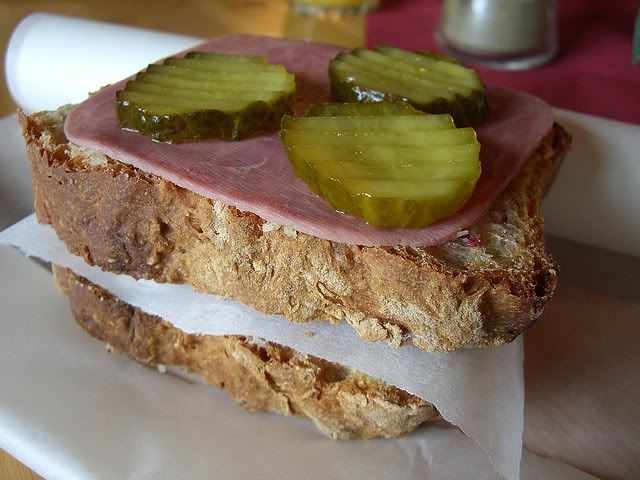A lot of people in the US have asked me about Norwegian food. First of all, it's very, very expensive. A liter of milk, for example, costs about 14 kroner--that comes out to something like $10 a gallon. A dozen eggs cost around $7. Norwegians, though, have the highest standard of living in the world. Apparently, this means they can afford their very expensive groceries. And maybe $10 a gallon for milk is what it costs to treat the cows humanely and to pay the farmers, the distributors, and the grocery store workers a comfortable salary (that's what I tell myself whenever I have to pay for groceries, anyway).
Eating out is even more expensive--unbelievably expensive. Just to give you an idea: I saw an adboard last week for a "Big Double Beef" cheeseburger with fries and a drink at
McDonald's for 99 kroner (more than $17)! The price is even higher if you eat there rather than taking it to go.
 |
| A Similar Norwegian "Value Meal" Ad |
So, naturally, we don't eat out much. Davin occasionally gets wined and dined because of work-related activities, but we've only been out to eat once as a family here--we went to a pizza place to celebrate our 9th wedding anniversary. It was worth it, though--it was good pizza, and we had a really nice time.
As far as what Norwegians "typically" eat, my experience is very limited. We don't know any native Norwegians well enough to know what they usually eat when they're at home. So my impressions mostly come from what's available at the grocery store.
But I have heard (and seen at Oscar's school) that a typical Norwegian breakfast, as well as a typical Norwegian lunch, consists of bread topped with butter/jam/cheese/meat/tomato/cucumber/etc. Sandwiches here are usually open-faced--it's un-Norwegian to put a piece of bread on top:
 |
| It's okay to have multiple layers of bread; you just have to be careful not to finish with a bread layer. |
Dinner is the main meal and often includes seafood. Seafood is huge here. Fresh, high-quality fish, shrimp, and oysters are easy to come by and not terribly expensive (relatively speaking). Bergen has a world-famous
fish market where you can find a huge variety of super-fresh seafood:
Dinner is usually served on the early side because, as I understand it, a fourth meal (kveltsmat - literally, "evening food") is standard here. I'm not sure what this meal normally consists of, but I get the impression that it's more of a snack than a meal.
The grocery stores here tend to be smaller, neighborhood shops. Selection is definitely more limited than in American stores, with some exceptions. When it comes to cheese and bread, for example, there are tons of options. And they have a staggering selection of hot dogs (
pølser). The bread is really good, and usually sold in freshly baked, unsliced loaves. Nearly every grocery store is equipped with a self-service electric bread slicer:
 |
| The Self-Service Bread Slicer: One of my Favorite Things about Norway |
Even though the grocery stores are small, we've been able to find most everything we're used to buying at home (or something roughly equivalent). We
are still looking for cheese sticks, maple syrup, and salted almonds, though. But while I wasn't surprised that we couldn't find some of the foods that were staples for our family in the US, I definitely
was surprised by some of the things that are staples here. The following are all products that are extremely easy to come by in Norway (in fact, the first three are served to the children at Oscar's school every single day):
 |
| Liver Paste - There are tins with boys on them for boys and tins with girls on them for girls. |
 |
| Caviar in a Tube |
 |
| Brunost (Brown Cheese) - It has a caramel color AND a caramel flavor. |
 |
| Reindeer Meat (Also Elk and Moose Meat) |
Interesting, no?







No comments:
Post a Comment